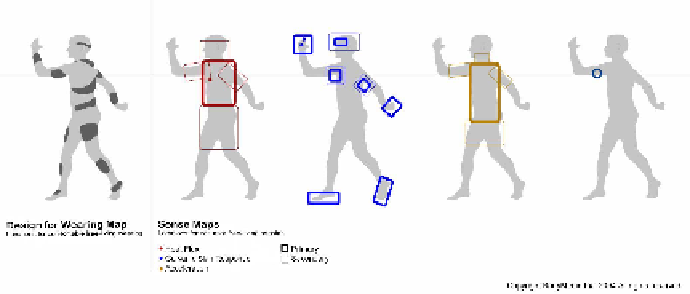Information Technology Reference
In-Depth Information
Fig. 2.
Shapes and positions from the original “Design for Wearability” study [7], far
left. To the right of this are four visualizations reflecting subsequent research in 1999.
These highlight sensor locations for heat flux, galvanic skin response, and acceleration.
The SenseWear armband location is identified far right.
the smallest and largest adult arm sizes. They fold inward to fit the smallest adult
female arm (down to 203mm/8” circumference) and expand to accommodate
the arms of large bodybuilders (up to 622mm/24.5” circumference) making the
system usable by virtually all adults.
SenseWear is made from molded plastics and surgical grade stainless steel,
materials approved in the USA for skin contact. The unit is easily cleaned. In
home use the unit might be wiped clean when washing one's self. In a clinical
setting the strap is changed and unit cleaned between subjects. The strap is
made from nylon, polyester, and polyisoprene (no latex) in three sizes: small, one
size fits most, and large. Specifically, the straps fit 140mm/5.5” - 241mm/9.5”,
203mm/8.5” - 432mm/17” and 406mm/16” - 622mm/24.5” arm circumferences.
By being readily cleanable, the sensor component is suitable for almost 24/7
wearing. When a user bathes they take it off with their clothes, replacing the
clothes and the armband at the same time. The straps are detachable for washing.
The suggested wearing duration is 23 hours in any 24 hour period.
The armband is minimally invasive. Furthermore, it is comfortable and in-
visible for most observers even if the user is wearing a short sleeved shirt. It is
in skin contact, but only at the surface, and is thus less intimidating or uncom-
fortable than semi-invasive sensor devices such as some blood-glucose meters,
or clinical heart rate monitors where electrodes are adhered to the skin. Com-
pletely invasive sensors such as implants have a certain positive unobtrusiveness
and 24/7 monitoring capabilities. An example of such a device is an implanted
loop recorder for cardiac care. However, by comparison, the process of implan-
tation is extremely expensive, and carries a substantial psychological barrier for
broad consumer use.
1.2 Real Time Versus Post Activity Analysis
The SenseWear armband is a ubiquitous computing device, however it is not al-
ways used as a real time device. Indeed for applications such as clinical study and

Search WWH ::

Custom Search